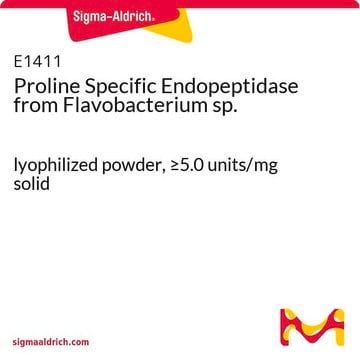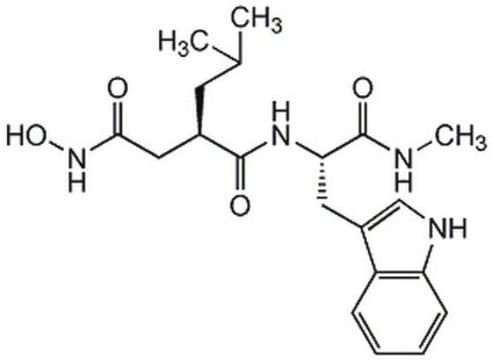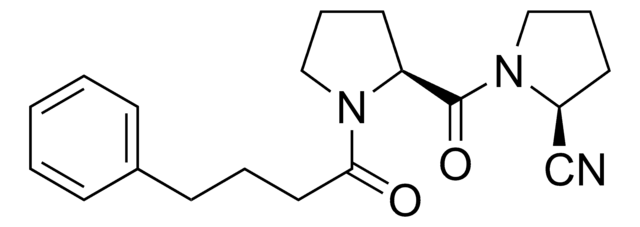537011
Prolyl Endopeptidase Inhibitor II
The Prolyl Endopeptidase Inhibitor II, also referenced under CAS 108708-25-4, controls the biological activity of Prolyl Endopeptidase. This small molecule/inhibitor is primarily used for Protease Inhibitors applications.
Sinonimo/i:
Prolyl Endopeptidase Inhibitor II, Z-PP-CHO
Autenticatiper visualizzare i prezzi riservati alla tua organizzazione & contrattuali
About This Item
Formula empirica (notazione di Hill):
C18H22N2O4
Numero CAS:
Peso molecolare:
330.38
Codice UNSPSC:
12352200
Prodotti consigliati
Livello qualitativo
Saggio
≥97% (HPLC)
Forma fisica
oil
Produttore/marchio commerciale
Calbiochem®
Condizioni di stoccaggio
OK to freeze
protect from light
Colore
colorless to off-white
Solubilità
DMSO: 10 mg/mL
DMF: soluble
ethyl acetate: soluble
Condizioni di spedizione
ambient
Temperatura di conservazione
−20°C
Descrizione generale
A cell-permeable dipeptide aldehyde that acts as a specific, potent, slow and tight-binding transition state analog inhibitor of prolyl endopeptidase (Ki = 350 pM and 500 pM for mouse brain and human brain prolyl endopeptidase, respectively). Reported to form a hemiacetal with the active-site serine.
A cell-permeable dipeptide aldehyde that acts as a specific, potent, slow, and tight-binding transition state analog inhibitor of prolyl endopeptidase (Ki = 350 pM and 500 pM for mouse brain and human brain, respectively). Reported to form a hemiacetal with the active site serine of the enzyme.
Azioni biochim/fisiol
Cell permeable: yes
Primary Target
Mouse brain prolylendooeotidase
Mouse brain prolylendooeotidase
Product does not compete with ATP.
Reversible: no
Target Ki: 350 pM and 500 pM for mouse brain and human brain prolyl endopeptidase, respectively
Confezionamento
Packaged under inert gas
Attenzione
Toxicity: Standard Handling (A)
Sequenza
Z-Pro-Pro-CHO
Ricostituzione
Following reconstitution, aliquot and freeze (-20°C). Stock solutions are stable for up to 3 months at -20°C.
Altre note
Fülöp, V., et al. 1998. Cell94, 161.
Kahyaoglu, A., et al. 1997. Biochem. J.322, 839.
Bakker, A.V., et al. 1990. Biochem. J.271, 559.
Wilk, S., and Orlowski, M. 1983. J. Neurochem.41, 69.
Kahyaoglu, A., et al. 1997. Biochem. J.322, 839.
Bakker, A.V., et al. 1990. Biochem. J.271, 559.
Wilk, S., and Orlowski, M. 1983. J. Neurochem.41, 69.
Note legali
CALBIOCHEM is a registered trademark of Merck KGaA, Darmstadt, Germany
Codice della classe di stoccaggio
10 - Combustible liquids
Classe di pericolosità dell'acqua (WGK)
WGK 1
Punto d’infiammabilità (°F)
Not applicable
Punto d’infiammabilità (°C)
Not applicable
Certificati d'analisi (COA)
Cerca il Certificati d'analisi (COA) digitando il numero di lotto/batch corrispondente. I numeri di lotto o di batch sono stampati sull'etichetta dei prodotti dopo la parola ‘Lotto’ o ‘Batch’.
Possiedi già questo prodotto?
I documenti relativi ai prodotti acquistati recentemente sono disponibili nell’Archivio dei documenti.
Zehavit Goldberg et al.
International journal of molecular sciences, 23(2) (2022-01-22)
The aim of this study was to characterize the distribution of the thrombin receptor, protease activated receptor 1 (PAR1), in the neuroretina. Neuroretina samples of wild-type C57BL/6J and PAR1-/- mice were processed for indirect immunofluorescence and Western blot analysis. Reverse
Chenxi Zhao et al.
Journal of neuroinflammation, 19(1), 189-189 (2022-07-17)
Nafamostat mesylate (nafamostat, NM) is an FDA-approved serine protease inhibitor that exerts anti-neuroinflammation and neuroprotective effects following rat spinal cord injury (SCI). However, clinical translation of nafamostat has been limited by an unclear administration time window and mechanism of action. Time
Valery Golderman et al.
Biomedicines, 10(6) (2022-06-25)
Thrombin is present in peripheral nerves and is involved in the pathogenesis of neuropathy. We evaluated thrombin activity in skin punch biopsies taken from the paws of male mice and rats and from the legs of patients with suspected small-fiber
Chenxi Zhao et al.
Neural regeneration research, 19(2), 434-439 (2023-07-25)
Argatroban is a synthetic thrombin inhibitor approved by U.S. Food and Drug Administration for the treatment of thrombosis. However, whether it plays a role in the repair of spinal cord injury is unknown. In this study, we established a rat
Mouhannad Malek et al.
Nature communications, 12(1), 2673-2673 (2021-05-13)
Vesicular traffic and membrane contact sites between organelles enable the exchange of proteins, lipids, and metabolites. Recruitment of tethers to contact sites between the endoplasmic reticulum (ER) and the plasma membrane is often triggered by calcium. Here we reveal a
Il team dei nostri ricercatori vanta grande esperienza in tutte le aree della ricerca quali Life Science, scienza dei materiali, sintesi chimica, cromatografia, discipline analitiche, ecc..
Contatta l'Assistenza Tecnica.






